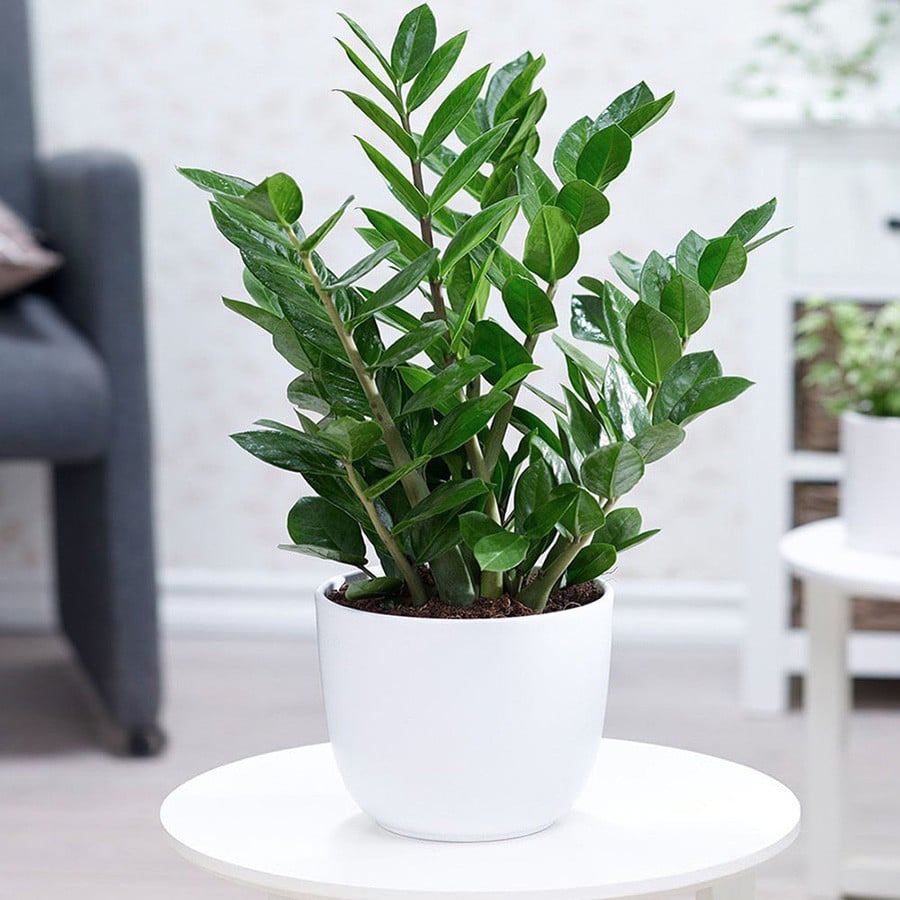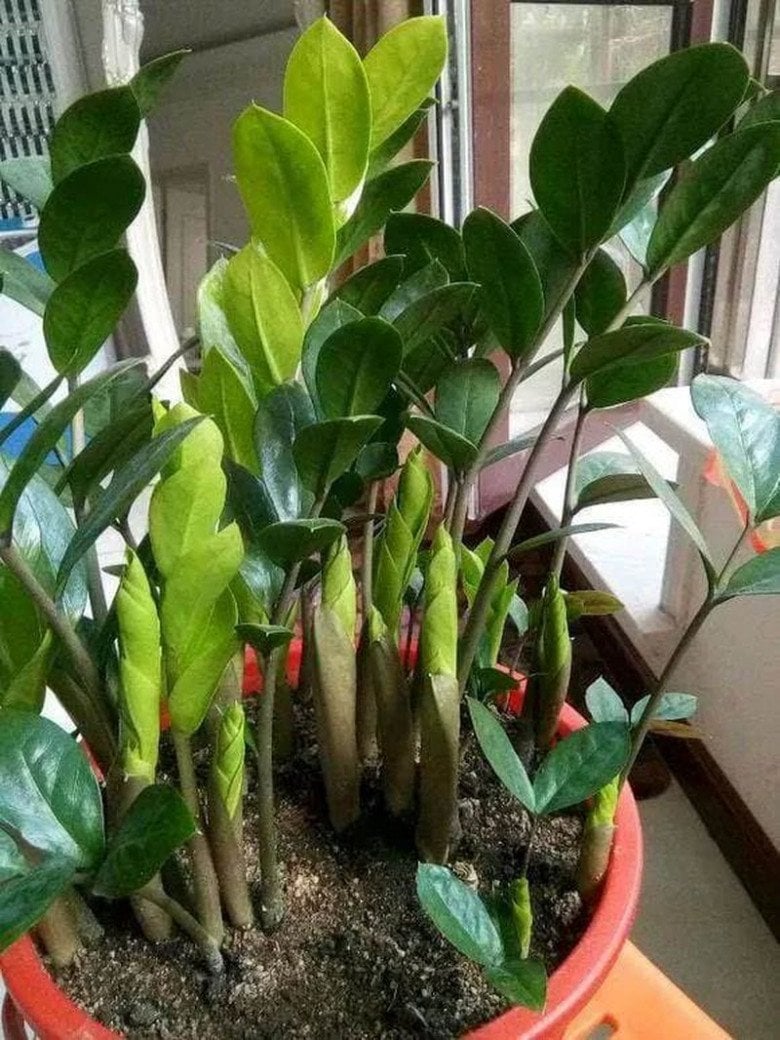
The more flowers the money tree has, the more luck it attracts: Do this and the money tree flowers will grow 5 times faster.
Although the ZZ plant (Zamioculcas zamiifolia) is known for being hardy and easy to grow, encouraging it to bloom is not a simple task. Not every ZZ plant will produce flowers, and achieving this result requires the right combination of care, environment, and patience.
For many plant lovers, a ZZ plant in bloom is considered a symbol of prosperity and good fortune. While the plant itself is low-maintenance, getting it to flower is a different story. Experienced gardeners often share their tips on how to create the ideal conditions for the ZZ plant to develop blossoms successfully.
1. Soil Requirements for ZZ Plants
If you want your ZZ plant to bloom, you must pay attention to all environmental factors—light, temperature, humidity, soil quality, and overall care.
ZZ plants require a loose, well-draining, nutrient-rich growing medium. Their underground rhizomes are quite delicate, and compacted soil can easily restrict growth or cause rot. A good soil mix combines alluvial soil, coconut coir, and charcoal or perlite, allowing excellent drainage and airflow while still retaining the nutrients needed for growth.
For best results, you can also mix in a small amount of slow-release organic matter to support long-term development. Healthy, strong roots are the foundation for potential flowering later on.
2. Fertilizing the ZZ Plant
With proper care, the ZZ plant may bloom once it develops enough mature stems, usually during spring or autumn. For this reason, these seasons are considered the best time to apply fertilizer that encourages blooming.
ZZ plants are vigorous growers, so they benefit from regular fertilization, especially during active growth periods. It is recommended to fertilize every three weeks during spring and autumn. Once the plant is well-established, you can switch to a monthly schedule.
Most gardening shops sell fertilizers specifically suitable for ZZ plants. Apply a small amount around the base of the plant, 10–15 cm away from the rhizome, to avoid burning the roots.
Avoid adding too much fertilizer at once. Instead, divide the feeding into smaller, more frequent doses to improve nutrient absorption. After fertilizing, water lightly so the nutrients dissolve and penetrate the soil.
Indoor plants that lack nutrients often show signs such as yellowing leaves, leaf drop, and slow growth. If you notice these symptoms, review the plant’s lighting conditions and watering habits in addition to increasing its nutrient intake.
(Extra content added): You may also alternate between organic fertilizers (like seaweed extract) and synthetic balanced fertilizers to give the plant a broader range of micronutrients. This balanced nutrition helps the plant build strong rhizomes and increases its chances of producing flowers.
3. Watering the ZZ Plant
ZZ plants naturally store water in their rhizomes, making them drought-tolerant and well-suited for dry environments. Because of this, they do not tolerate overwatering. If the soil stays wet for too long, the plant will develop yellow leaves and root rot.
Follow the golden rule: water only when the soil is completely dry. You can insert a chopstick into the soil to check moisture levels—if it comes out clean and dry, it’s time to water. If it is still damp, wait a few more days.
Avoid watering too frequently or using pots with poor drainage. Excess moisture can cause the rhizomes and stems to become mushy and eventually rot.
The best method is to use a spray bottle to mist the leaves and topsoil lightly. This keeps the plant fresh without drowning the roots. To maintain shiny and attractive foliage, wipe the leaves occasionally with a damp cloth to remove dust and enhance photosynthesis.
(Extra content added): During hotter months, you may slightly increase watering frequency, but always observe the soil first. In winter, watering should be reduced significantly because the plant enters a slower metabolic state.
4. Providing Adequate Light

Light is crucial for the ZZ plant’s growth and overall appearance, but the plant does not tolerate harsh, direct sunlight. Intense sunlight can scorch the leaves and cause them to fade or curl.
When grown indoors, if the plant becomes leggy, pale, or begins to droop, it is a sign that it needs more light. Move it to a bright area with indirect sunlight, such as near a window, on a balcony with filtered light, or in a well-lit living room.
With sufficient light and airflow, the ZZ plant can photosynthesize more efficiently, leading to lush green foliage and improving its chance of blooming.
(Extra content added): Rotating the pot every two weeks ensures even growth on all sides, preventing the plant from leaning toward a single light source.
5. Temperature and Humidity
The ZZ plant adapts well to different environmental conditions, but it thrives best at temperatures between 25–27°C. When temperatures drop below 18°C, the plant may shed leaves and enter a semi-dormant state. At temperatures below 5°C, it will not survive.
One advantage of the ZZ plant is that it can tolerate both high and low humidity levels. However, maintaining moderate humidity helps the plant stay healthy and avoids issues like dry leaf tips.
(Extra content added): Keeping the plant away from air conditioners, heaters, or drafts will help maintain stable humidity and temperature—two important factors for supporting flowering.
If you consistently maintain these favorable conditions—proper soil, balanced nutrition, careful watering, adequate light, and ideal temperature—the ZZ plant is much more likely to bloom. While flowering is still relatively rare, the right environment greatly increases your chances of witnessing this special event.
News in the same category


My nana taught me this hack to get rid of dark circles in 5 mins with 0 work. Here’s how it works

Put a cotton ball with VapoRub in your ear & get this remarkable effect

A Drink That May Help Reduce Cancer Risk: Not Tea or Coffee

Tips for preserving ginger without refrigeration

Whether It’s AA or AAA, Don’t Throw Them Away When They Run Out — Here’s a Simple Way to Revive Batteries in 10 Seconds

If the fan is dirty, you don't need to remove the frame or use water

Placing a Sock on Top of Your Air Conditioner: A Small Trick With Big Benefits—Especially on Scorching Days

My nana taught me this hack to strengthen thinning hair in 7 mins with 0 work. Here’s how it works

When you buy cilantro, don't put it in the refrigerator right away

Simple Tips to Clean Your Phone’s Speaker at Home — Anyone Can Do It

How to Grow Sweet Potatoes in Bags Using Simple Sprouts – High Yield Method

When cooking crab soup, just add this, the crab bricks will form large, beautiful blocks

Applying ginger to the navel

Placing a Dish of Salted Lemons by Your Bed: 5 Powerful Benefits Few People Know About

Add a few drops of essential oil to the cleaning water.

Large Navel Oranges vs Small Navel Oranges

How to make delicious and attractive steamed chicken with lotus leaves
News Post

Vaseline Uses and Benefits for Skin, Lips, and Hair

10 simple ways to reduce dust at home that most people overlook

You’re Doing It All Wrong: Here’s the Right Way to Defrost Frozen Pipes

7 Powerful Fruits to Preserve Muscle Strength and Energy After 50

I Didn’t Know!

The #1 FASTEST way to reverse fatty liver naturally

Could the bacteria in your nose be causing Alzheimer’s?

How to treat nerve pain in the foot, toes & legs

The air conditioner only has wind but is not cool. Don't rush to call a repairman and waste money. If you do this, it will be cold.

When boiling duck, don't add ginger and cold water. Add this to remove all the bad smell from the meat and you won't get tired of eating it.

Avocado Seeds: The Overlooked Nutritional Power Inside the Fruit

Bee venom wiped out 100% of aggressive breast cancer cells in just 6 hours

A New Breakthrough: Magnetic Microrobots Designed to Navigate Blood Vessels and Stop Strokes

10 Ways to Lower Uric Acid Naturally

A Dual Climate Solution: Solar Panels Over Canals Could Save Billions of Gallons of Water

Regenerative Medicine Milestone: Stem-Cell Trial Restores Motor Function in Paralyzed Patients

From Crow to Cleaner: How Feathered Geniuses Are Fighting Litter in Spain

6 Foods That Can Drain Your Calcium and Weaken Bones
